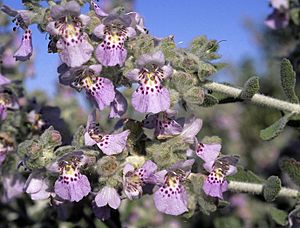Saltbush foxglove facts for kids
Quoya atriplicina, commonly known as saltbush foxglove, is a beautiful flowering plant that belongs to the mint family called Lamiaceae. You can only find this plant growing naturally in Western Australia. It's a bushy plant with soft, greyish hairs covering its branches and leaves. Its leaves are wide and round, and its tube-shaped flowers are pink with purple spots inside.
Quick facts for kids Saltbush foxglove |
|
|---|---|
 |
|
| Quoya atriplicina in Francois Peron National Park | |
| Scientific classification | |
| Genus: |
Quoya (plant)
|
| Species: |
atriplicina
|
 |
|
| Occurrence data from ALA | |
| Synonyms | |
Contents
What Does Saltbush Foxglove Look Like?
Saltbush foxglove is a bushy plant with many branches. It can grow to be about 1 to 2.5 meters (3 to 8 feet) tall. Its branches are covered with short, greyish hairs, making them look soft.
The leaves are wide and almost round. They are about 1 to 2.5 centimeters (0.4 to 1 inch) long and wide. The small, ash-colored hairs often hide the veins on the leaves.
Its Flowers
The flowers grow in groups of 3 to 7 flowers. These groups are found where the leaves meet the stem, often forming a short, leafy cluster. Each flower group sits on a small stalk, about 2 to 4 millimeters (0.08 to 0.16 inches) long, also covered in ash-colored hairs.
Each flower is surrounded by small leaf-like parts called bracts and bracteoles. These are hairy on the outside but smooth on the inside. The five sepals (which protect the flower bud) are joined together to form a tube, about 6 to 8 millimeters (0.24 to 0.31 inches) long. This tube is very hairy on the outside.
The petals are pink with purple spots inside, especially in the throat of the flower. They form a tube that is about 15 to 25 millimeters (0.6 to 1 inch) long. This tube has a wide opening and five short, broad lobes (sections). The lowest lobe is the largest and is almost perfectly round. The outside of the petal tube is hairy, but the inside is smooth, except for a ring of hairs around the ovary (where seeds develop).
The flower has four stamens (the parts that produce pollen) inside the tube. They are about the same length as the tube, with one pair being a bit shorter than the other.
When Does It Flower and Fruit?
Saltbush foxglove usually flowers from May to October or November. After flowering, it produces oval-shaped fruits, about 3 to 4 millimeters (0.12 to 0.16 inches) long. These fruits are very hairy, and the sepals stay attached to them.
How Did Saltbush Foxglove Get Its Name?
This plant was first officially described in 1859 by a scientist named Ferdinand von Mueller. He first called it Chloanthes atriplicina. He wrote about it in a publication called Fragmenta phytographiae Australiae. He studied a plant sample collected by Augustus Oldfield near the Murchison River.
Later, in 1870, another scientist named George Bentham changed its name to Pityrodia atriplicina. But in 2011, two scientists, Barry Conn and Murray Henwood, changed it back to Quoya atriplicina. They published this change in a scientific journal called Australian Systematic Botany.
The second part of its scientific name, atriplicina, comes from the name of another plant genus called Atriplex, which is a type of saltbush. This is why it's commonly called "saltbush foxglove."
Where Does Saltbush Foxglove Grow?
Saltbush foxglove grows in sandy areas, mainly between the towns of Geraldton and Shark Bay in Western Australia. It can be found in specific natural areas known as the Carnarvon, Geraldton Sandplains, and Yalgoo biogeographic regions.
Is Saltbush Foxglove Endangered?
The Western Australian Government Department of Parks and Wildlife has classified Quoya atriplicina as "not threatened." This means it is not currently at risk of disappearing.

